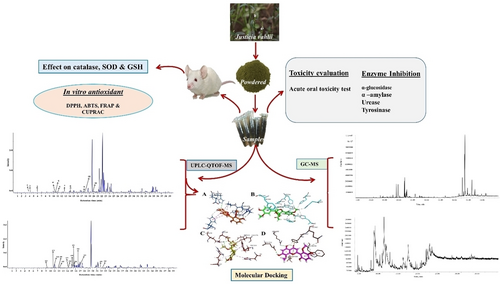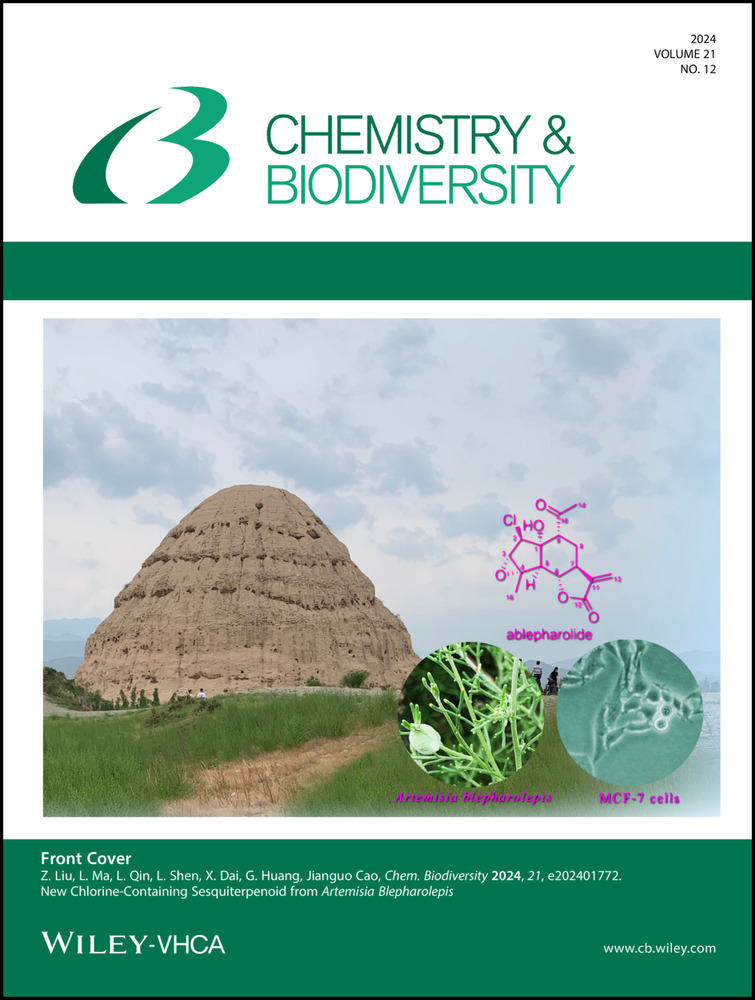Unrivalled Insight into Possible Biopharmaceutical Application of Justicia vahlii Roth. (Acanthaceae): Chemodiversity, In Vitro Bioactivities, and Computational Analysis
Abdul Basit
Department of Pharmaceutical Chemistry, Faculty of Pharmacy, The Islamia University of Bahawalpur, Bahawalpur, Punjab, 63100 Pakistan
Department of Pharmaceutical Chemistry, Faculty of Pharmaceutical Sciences, Prince of Songkla University, Hat Yai, 90010, Songkhla Thailand
Drug Delivery System, Excellence Center, Faculty of Pharmaceutical Sciences, Prince of Songkla University, Hat Yai, 90010, Songkhla Thailand
Contribution: Formal analysis (lead)
Search for more papers by this authorSaeed Ahmad
Department of Pharmaceutical Chemistry, Faculty of Pharmacy, The Islamia University of Bahawalpur, Bahawalpur, Punjab, 63100 Pakistan
Contribution: Supervision (lead)
Search for more papers by this authorChitchamai Ovatlarnporn
Department of Pharmaceutical Chemistry, Faculty of Pharmaceutical Sciences, Prince of Songkla University, Hat Yai, 90010, Songkhla Thailand
Drug Delivery System, Excellence Center, Faculty of Pharmaceutical Sciences, Prince of Songkla University, Hat Yai, 90010, Songkhla Thailand
Contribution: Supervision (equal)
Search for more papers by this authorMuhammad Adeel Arshad
Department of Pharmaceutical Chemistry, Faculty of Pharmaceutical and Allied Health Science, Lahore College for Women University, Lahore, 51000 Pakistan
Contribution: Methodology (lead)
Search for more papers by this authorMuhammad Farrukh Saleem
Department of Pharmaceutical Chemistry, Faculty of Pharmacy, The Islamia University of Bahawalpur, Bahawalpur, Punjab, 63100 Pakistan
Contribution: Resources (lead)
Search for more papers by this authorCorresponding Author
Umair Khurshid
Department of Pharmaceutical Chemistry, Faculty of Pharmacy, The Islamia University of Bahawalpur, Bahawalpur, Punjab, 63100 Pakistan
Contribution: Supervision (supporting)
Search for more papers by this authorCorresponding Author
Hammad Saleem
Institute of Pharmaceutical Sciences (IPS), University of Veterinary &Animal Sciences (UVAS), Lahore, 51000 Pakistan
Search for more papers by this authorKashif ur Rehman Khan
Department of Pharmaceutical Chemistry, Faculty of Pharmacy, The Islamia University of Bahawalpur, Bahawalpur, Punjab, 63100 Pakistan
Contribution: Supervision (supporting)
Search for more papers by this authorSafiullah Khan
Cadson College of Pharmacy, Kharian, Punjab, 50090 Pakistan
Contribution: Visualization (lead)
Search for more papers by this authorHamad M. Alkahtani
Department of Pharmaceutical Chemistry, College of Pharmacy, King Saud University, P.O. Box 2457, Riyadh, 11451 Saudi Arabia
Contribution: Writing - original draft (lead)
Search for more papers by this authorAmer Alhaj Zen
Chemistry & Forensics Department, Clifton Campus, Nottingham Trent University, Nottingham, Ng11 8NS UK
Contribution: Writing - review & editing (lead)
Search for more papers by this authorAbdul Basit
Department of Pharmaceutical Chemistry, Faculty of Pharmacy, The Islamia University of Bahawalpur, Bahawalpur, Punjab, 63100 Pakistan
Department of Pharmaceutical Chemistry, Faculty of Pharmaceutical Sciences, Prince of Songkla University, Hat Yai, 90010, Songkhla Thailand
Drug Delivery System, Excellence Center, Faculty of Pharmaceutical Sciences, Prince of Songkla University, Hat Yai, 90010, Songkhla Thailand
Contribution: Formal analysis (lead)
Search for more papers by this authorSaeed Ahmad
Department of Pharmaceutical Chemistry, Faculty of Pharmacy, The Islamia University of Bahawalpur, Bahawalpur, Punjab, 63100 Pakistan
Contribution: Supervision (lead)
Search for more papers by this authorChitchamai Ovatlarnporn
Department of Pharmaceutical Chemistry, Faculty of Pharmaceutical Sciences, Prince of Songkla University, Hat Yai, 90010, Songkhla Thailand
Drug Delivery System, Excellence Center, Faculty of Pharmaceutical Sciences, Prince of Songkla University, Hat Yai, 90010, Songkhla Thailand
Contribution: Supervision (equal)
Search for more papers by this authorMuhammad Adeel Arshad
Department of Pharmaceutical Chemistry, Faculty of Pharmaceutical and Allied Health Science, Lahore College for Women University, Lahore, 51000 Pakistan
Contribution: Methodology (lead)
Search for more papers by this authorMuhammad Farrukh Saleem
Department of Pharmaceutical Chemistry, Faculty of Pharmacy, The Islamia University of Bahawalpur, Bahawalpur, Punjab, 63100 Pakistan
Contribution: Resources (lead)
Search for more papers by this authorCorresponding Author
Umair Khurshid
Department of Pharmaceutical Chemistry, Faculty of Pharmacy, The Islamia University of Bahawalpur, Bahawalpur, Punjab, 63100 Pakistan
Contribution: Supervision (supporting)
Search for more papers by this authorCorresponding Author
Hammad Saleem
Institute of Pharmaceutical Sciences (IPS), University of Veterinary &Animal Sciences (UVAS), Lahore, 51000 Pakistan
Search for more papers by this authorKashif ur Rehman Khan
Department of Pharmaceutical Chemistry, Faculty of Pharmacy, The Islamia University of Bahawalpur, Bahawalpur, Punjab, 63100 Pakistan
Contribution: Supervision (supporting)
Search for more papers by this authorSafiullah Khan
Cadson College of Pharmacy, Kharian, Punjab, 50090 Pakistan
Contribution: Visualization (lead)
Search for more papers by this authorHamad M. Alkahtani
Department of Pharmaceutical Chemistry, College of Pharmacy, King Saud University, P.O. Box 2457, Riyadh, 11451 Saudi Arabia
Contribution: Writing - original draft (lead)
Search for more papers by this authorAmer Alhaj Zen
Chemistry & Forensics Department, Clifton Campus, Nottingham Trent University, Nottingham, Ng11 8NS UK
Contribution: Writing - review & editing (lead)
Search for more papers by this authorAbstract
Justicia vahliiRoth. is an important wild medicinal food plant traditionally used for treating inflammation and various common ailments. This study investigated the chemical composition, antioxidant, enzyme inhibition and toxicity profiles of n-hexane (nHEJv) and chloroform (CEJv) extracts of J. vahlii. Moreover, the effect of the extracts was evaluated on CCl4 induced liver injury. The total phenolic and flavonoid contents were present in both extracts in significant amount. The UPLC−Q-TOF-MS and GC-MS profiling of CEJv tentatively identified several important phytocompounds. The CEJv extract was comparatively more active for antioxidant activity and α-amylase inhibition, whereas the nHEJv extract presented higher inhibition potential against urease, tyrosinase, and α-glucosidase enzymes. Similarly, the in-silicostudy of four major compounds, i. e., 1-acetoxypinoresinol, 3-hydroxysebacic acid, nortrachelogenin, and viscidulin-III have shown a good docking score against the clinically significant enzymes. The acute oral toxicity and brine shrimp lethality assaysrevealed the extracts as non-toxic. The CCl4 treated animals showed a geared depletion of various antioxidant enzymes which were significantly reversed with the treatment of the extracts. Overall, the study's findings revealed J. vahliiwith antioxidant mediated hepatoprotective and enzyme inhibition potential and warrant further research on isolation of the bioactive compounds.
Graphical Abstract
Conflict of Interests
The authors declare that the research was conducted in the absence of any commercial or financial relationships that could be construed as a potential conflict of interest.
Open Research
Data Availability Statement
The data that support the findings of this study are available from the corresponding author upon reasonable request.
Supporting Information
As a service to our authors and readers, this journal provides supporting information supplied by the authors. Such materials are peer reviewed and may be re-organized for online delivery, but are not copy-edited or typeset. Technical support issues arising from supporting information (other than missing files) should be addressed to the authors.
| Filename | Description |
|---|---|
| cbdv202401432-sup-0001-misc_information.pdf1.4 MB | Supporting Information |
Please note: The publisher is not responsible for the content or functionality of any supporting information supplied by the authors. Any queries (other than missing content) should be directed to the corresponding author for the article.
References
- 1C. Forni, et al. BioMed research international 2019, 1, 8748253..
- 2L. Deng, Liling, et al. Oxidative medicine and cellular longevity 2021, 8852759.
- 3A. Basit, et al., Food Biosci. 2023, 56, 103058.
- 4S. Ahmad, et al., J. Herb. Med. 2019, 16, 1–5.
10.1016/j.hermed.2019.100258 Google Scholar
- 5M. Fukui, B. T. Zhu, Free Radic. Biol. Med. 2010, 48(6), 821–830.
- 6M. Y. Ansari, N. Ahmad, T. M. Haqqi, Biomed. Pharmacother. 2020, 129(1), 110452.
- 7R. Zhu, et al., Hepatol. Res. 2012, 42(8), 741–749.
- 8A. Stefanucci, et al., Food Chem. Toxicol. 2018, 118, 181–189.
- 9U. Shabbir, et al., The Potential Role of Polyphenols in Oxidative Stress and Inflammation Induced by Gut Microbiota in Alzheimer's Disease 2021. 10(9), 1370.
- 10R. Dilshad, et al., Arabian J. Chem. 2022, 15(10), 104133.
- 11B. Chen, et al., Nutr. Neurosci. 2022, 25(5), 1078–1099.
- 12A. Stefanucci, et al., J. Funct. Foods 2020, 73, 104154.
- 13A. Pieczykolan, et al., Molecules 2021, 26(12), 3486.
- 14R. Dilshad, et al., Biomed. Res. Int. 2022, 2022, 8010395.
- 15A. Basit, et al., J. Ethnopharmacol. 2022, 287, 114942.
- 16J. Ellis, Nelumbo 1988, 30(1–4), 126–133.
- 17A. Farooq, et al., J. Ethnobiol. Ethnomed. 2019, 15(1), 45.
- 18H. Abbas, M. Qaiser, Pak. J. Bot. 2011, 43(5), 2351–2357.
- 19G. M. Corrêa, A. F. d. C. Alcântara, Rev. Bras. Farmacogn. 2012, 22(1), 220–238.
- 20S. Uysal, et al., Food Chem. Toxicol. 2018, 111, 525–536.
- 21M. M. Hayat, M. Uzair, Biomed. Res. 2019, 30(4), 609–616.
- 22U. Khurshid, et al., Ind. Crops Prod. 2019, 142, 111861.
- 23A. Basit, et al., Front. Chem.10, 1577.
- 24P. Elmer, Chem Bio Draw Profeesional Version (15.0. 0.106), Cambridge Soft, Waltham, MA 2017.
- 25D. S. Biovia, Discovery Studio Client, DassaultSystèmes, San Diego 2019.
- 26H. M. Berman, et al., Nucleic Acids Res. 2000, 28(1), 235–242.
- 27S. Malik, et al., Bioorg. Chem. 2019, 84, 372–383.
- 28H. Saleem, et al., Drug. Dev. Ind. Pharm. 2020, 46(5), 861–868.
- 29K. Yamamoto, et al., FEBS J. 2010, 277(20), 4205–4214.
- 30S. C. Lovell, et al., Proteins: Str. Funct. Bioinform. 2003, 50(3), 437–450.
- 31F. Khuda, et al., Pak. J. Pharm. Sci. 2012, 25(1), 51–58.
- 32B. Chance, A. Maehly, Assay of Catalases and Peroxidases 1955, 764–775
- 33P. Kakkar, B. Das, P. Viswanathan, Int. J. Biol. Biotechnol. 1984, 21(2), 130–132.
- 34R. A. Khan, et al., BMC Complement. Altern. Med. 2012, 12(1), 1–8.
10.1186/1472-6882-12-1 Google Scholar
- 35B. Ahmad, M. R. Khan, N. A. Shah, Toxicol. Ind. Health 2015, 31(12), 1243–1251.
- 36M. N. Shahzad, et al., PloS One 2022, 17(3), e0266094.
- 37L. Yang, et al., Biomed Res. Int. 2020, 25, 1–10.
- 38M. F. Yam, et al., J. Ethnopharmacol. 2009, 123(2), 244–249.
- 39M. F. Yam, A. Sadikun, M. Ahmad, G. A. Akowuah, M. Z. Asmawi, Journal of ethnopharmacology 2009, 123(2), 244–249.
- 40J. Chanda, et al., Phytochem. Anal. 2019, 30(2), 148–155.
- 41X. He, et al., Phytochem. Anal.2021, 32, 1–10.
- 42Y. Qi, et al., Talanta 2014, 118, 21–29.
- 43L. He, et al., J. Pharm. Biomed. Anal. 2016, 117, 125–139.
- 44L. Hu, et al., Biomed. Chromatogr. 2020, 34(8), 1–14.
10.1002/bmc.4849 Google Scholar
- 45Y. He, et al., Molecules 2018, 23(9), 2189.
- 46T. Brito, et al., Food Chem. 2021, 339(1), 1–11.
- 47A. G. Cunha, et al., J. Chromatogr. B 2017, 1051(15), 24–32.
- 48A. Balkrishna, et al., Pharmaceuticals 2021, 14(4), 297.
- 49A. Fattahi, et al., Food Sci. 2021, 9(8), 4278–4286.
- 50Z. Chen, et al., Arab. J. Chem. 2021, 14(6), 103151.
- 51P. C. Eklund, et al., J. Mass Spectrom. 2008, 43(1), 97–107.
- 52S. Ghisoni, et al., J. Funct. Foods 2017, 34, 229–236.
- 53D. Peng, et al., Process 2019, 7(10), 764.
- 54B. Zhong, et al., Mar. Drugs 2020, 18(6), 331.
- 55A. I. Elshamy, et al., Molecules 2020, 25(18), 4234.
- 56S. G. Duan, et al., Phytochemistry 2021, 184, 112655.
- 57B. Zhuang, et al., J. Pharm. Biomed. Anal. 2018, 154, 207–215.
- 58B. Avula, et al., Pharmazie 2006, 61(7), 590–594.
- 59B. Ma'arif, A. Suryadinata, H. Laswati, M. Agil, Journal of Tropical Pharmacy and Chemistry 2019, 4(6), 261–270.
10.25026/jtpc.v4i6.213 Google Scholar
- 60B. Yang, et al., J. Ethnopharmacol. 2020, 256(3), 1–11.
- 61I. Ahmad, et al., S. Afr. J. Bot. 2022, 148, 200–209.
- 62G. M. Corrêa, A. F. d. C. Alcântara, Rev. Bras. Farmacogn. 2012, 22, 220–238.
- 63G. Zengin, et al., J. Pharm. Biomed. Anal. 2018, 149, 436–441.
- 64N. Singh, et al., Curr. Bioact. Compd. 2021, 17(2), 112–119.
- 65M. M. Elmazar, et al., PLoS One 2013, 8(1), e45638.
- 66P. Ciganović, et al., Antioxidants 2019, 8(10), 445.
- 67A. Farasat, et al., BioTechnologia 2020, 101(3), 193–204.
- 68H. Mobley, Aliment. Pharmacol. Ther. 1996, 10(Sup1), 57–64.
- 69N.-C. Ha, et al., Nature structural biology, 8(6), 505–509.
- 70Z. P. Xiao, et al., Eur. J. Med. Chem. 2010, 45(11), 5064–5070.
- 71P. Liu, et al., J. Nat. Med. 2019, 73(1), 124–130.
- 72A. Basit, et al., Arabian J. Chem. 2022, 15(10), 104135.
- 73S. Szymonik-Lesiuk, et al., J. Hepatobiliary Pancreat. Surg. 2003, 10(4), 309–315.
- 74W. Ruankham, et al., Nutr. Neurosci. 2021, 24(2), 90–101.





